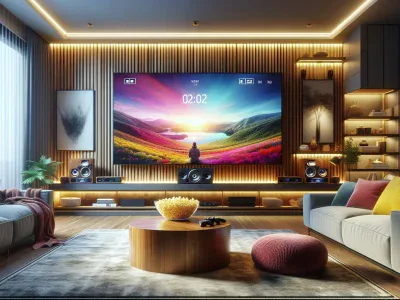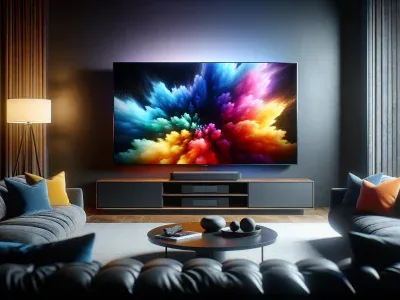Which Is Better Hisense or TCL? In-Depth Comparison for the Best Home Cinema Experience
Picture yourself sinking into your favorite chair as the lights dim and the screen flickers to life. The colors pop the sound wraps around you and for a moment the world outside disappears. But which TV brand delivers that cinematic magic—Hisense or TCL? The choice isn’t as simple as it seems.
You might think it’s all about price tags or flashy specs but there’s a world of hidden features and unexpected perks waiting to be uncovered. From dazzling picture quality to smart features that make your life easier each brand brings something unique to the table. So which one will transform your living room into the ultimate entertainment oasis? Let’s immerse and unravel the secrets behind these two TV giants.
Overview of Hisense and TCL
Both Hisense and TCL, two global electronics manufacturers, build televisions that transform your living room into something like a bustling movie theater. Hisense, a Chinese company founded in 1969, operates in international markets, selling products in over 130 countries. TCL, founded in 1981, also in China, delivers smart TVs in more than 160 regions. Picture browsing through a busy electronics aisle; dazzling screen displays from both companies catch your eye. Some shoppers reminisce about first unboxing a TCL Roku TV, marveling at how easily streaming apps loaded right out of the box. Others remember Hisense’s smooth, bright panels elevating a family movie night—kids reaching for popcorn while dolphins leap across the screen in 4K clarity.
You might ask, how do these brands stack up innovation? Hisense often chooses to push boundaries with their ULED technology and partnerships for events like the FIFA World Cup (source: Hisense Corporate). TCL forms collaborations with Roku and Google, prioritizing a user-friendly smart experience (source: TCL Global). Price tags hover in similar ranges—almost daring you to spot the difference—while features sometimes diverge under the surface.
Here’s a question worth pondering: Does a TV’s country of origin matter to you, or do you focus more on reliability and after-sales support? Reviews on forums like AVSForum or Reddit tend to highlight that both these brands, while budget-friendly, manage to surprise users with color vibrancy or smart OS responsiveness usually reserved for higher-end competitors.
Evaluating Hisense and TCL, think of each brand as a different route on a winding mountain road—both get you to the peak of cinematic immersion, but each promises a distinct vista along the way.
Key Features Comparison
Explore Hisense and TCL by dissecting the core features that decide your cinematic journey. Picture clarity, smart usability, audio depth, and visual design all set the tone for your home theater’s ambiance.
Picture Quality
Hisense and TCL redefine clarity, but their secret ingredients vary. Hisense’s ULED panels boost luminance through quantum dots, pushing brightness past 700 nits in the U8K (RTINGS). TCL’s QLED TVs, like the 6-Series, bring Mini-LED backlights—they stretch local dimming zones, painting deeper blacks around neon cityscapes in Blade Runner 2049. Some users ask: does artificial contrast create a more lifelike night scene or is it more about color volume during animated features? Hisense upscales content with AI-driven processors, revealing wrinkles on actors’ faces. TCL opts for Dolby Vision IQ, adjusting colors dynamically as ambient light tiptoes across your living room walls. If friends argue over vibrant animation versus crisp live-action, both camps claim their corners—with sports fans noting Hisense’s faster motion smoothing for rapid soccer passes.
Smart TV Platforms
The battle for OS dominance mixes user habit and content abundance. Hisense usually rolls out Google TV, so you navigate with a familiar tile grid and voice control that fetches obscure directors on command. TCL offers both Roku and Google TV—in the US, Roku’s blocky interface opens up channel apps instantly, and you swap between The Office reruns and YouTube without a hiccup. There’s a question around “openness”: TCL’s Roku lock ecosystem might lead you to quick setup but restricts custom app installs, while Hisense with Google TV nudges smart home tinkerers closer to their Nest devices and Google Assistant routines. If your friend calls to ask where the HBO Max button went, you know how OS shape the daily movie hunt.
Sound Performance
Hisense and TCL deliver audio that comes as surprise, as built-in speakers rarely impress. Hisense’s U8K projects sound by reflecting it off the ceiling, simulating surround effects as a helicopter whirls overhead in Dunkirk. TCL’s 6-Series, but, carries Dolby Atmos passthrough—plug a soundbar and it lets raindrop effects patter behind your sofa. In reviews from CNET and AVForums, Hisense integrated subwoofers sometimes rattle bookshelves more than dialogue. TCL’s approach stays restrained but sometimes needs a dedicated sound system to avoid voices feeling distant during dramatic monologues.
Design and Build Quality
TVs double as design statements in your home. Hisense outfits recent models with slim metal bezels and floating stands, so if your space craves minimalist lines, it blends like the edge of a museum painting. TCL matches elegance with practicality, its brushed metal frames sturdy enough that one person can unbox and set up a 65-inch without wrestling the package. If you visit a friend’s apartment, you might notice that some TCL legs can slide inward to fit narrow consoles, a detail overlooked by many brands. Still, some users report Hisense’s panel sometimes flexes with wall mounts, so double-check brackets for sturdy installs.
| Feature | Hisense ULED Example | TCL QLED Example | Key Semantic Entities |
|---|---|---|---|
| Display Tech | ULED, Quantum Dot | QLED, Mini-LED | luminance, local dimming |
| OS | Google TV | Roku TV, Google TV | voice control, content grid |
| Audio | Integrated subwoofer | Dolby Atmos passthrough | surround sound, soundbar |
| Build | Slim bezels, metal finishes | Adjustable legs, metal frame | design, panel flex |
Would you trade richer sound for a seamless streaming experience? Is your living room lighting a silent character in movie night? Explore each vector—picture, interface, audio, and design. It’s the blend of these features that shapes your home cinema story.
Price and Value for Money
Compare Hisense and TCL on price, you stumble into a chess game where every move, every feature, and every dollar counts. Hisense TVs, for instance, can often undercut TCL by $20–$50 for similar 55-inch 4K models at Walmart or Best Buy. Yet TCL sometimes flips the board with flash sales on its Roku-enabled sets, making you wonder if you’re spotting a hidden gem or stepping into a discount illusion.
Scan budget 4K TVs, and you’ll find the Hisense A6 Series holding court under $300, sometimes bundled with gift cards or extended trial periods. TCL’s S4 or 4-Series sidles up next to it, shrugs, and offers native Roku integration plus voice remotes at the same price point, but when you look closely, you might notice TCL pushing out more frequent firmware updates for older models.
Take a leap into the $500–$800 segment. Here, both brands unfurl their more ambitious banners: Hisense drops its U7K ULED with 120Hz panels while TCL answers with the Q7 QLED, boasting Mini-LED backlighting. Both promise cinema-level visuals, but which would make you pause longer at the checkout page? Hisense frequently packs in extras like Dolby Vision IQ and a built-in subwoofer, making you consider if “value” means specs density or smoother deals. TCL hangs its hat on an intuitive, ad-free Roku interface and longer OS support windows.
For reference, you might want to check average prices for their best sellers:
| Brand | Model | Size | Tech | Typical Price ($USD) | Notable Value Perks |
|---|---|---|---|---|---|
| Hisense | A6 Series | 55” | 4K LED | $270–$320 | Gift bundles, trial offers |
| Hisense | U7K ULED | 65” | ULED, 120Hz | $650–$800 | Dolby Vision IQ, subwoofer |
| TCL | S4/Roku 4-Series | 55” | 4K LED | $270–$340 | Roku, rapid firmware |
| TCL | Q7 QLED | 65” | Mini-LED | $650–$850 | Mini-LED, Roku ecosystem |
If you ever wandered an electronics aisle, hands flicking from one branded remote to another, you know the familiar ache: is saving $50 worth a missing app or losing a little brightness? Maybe your neighbor once swore that his TCL’s streaming never lags, unlike that night your brother’s Hisense hiccuped during a World Cup shootout.
Questions of value pivot not just on what sits in the box but on what lives beyond it: update promises, ecosystem fit, warranty limits, and even retail return policies. Is it “cheaper” if it lasts longer, or only if you feel bolder showing off Dolby Vision to your watch party crew? You might never see every feature in daily use, but the illusion of “getting more” can tug, almost like gravity, at your final decision.
So, dollar for dollar, which brand wins? Consider the chessboard anew: sometimes you pay for kings, sometimes for clever pawns, but you never quite buy certainty. And would you rather brag about saving more or about streaming in style?
User Experience and Customer Support
Navigating the world of Hisense and TCL TVs often feels like stepping onto a high-speed subway: If you blink, you could miss the platform you wanted. Hisense wraps you in a user experience that’s a bit like walking through a bright pop-up gallery—quick loading, vivid menus, voice assistants ready to respond. Take the Hisense U8 Series as an example; Google TV integration means your home screen greets you with content that already matches your tastes. Dragging apps is simple, maybe even too simple, but some’ve noticed the occasional lag when switching sources. Still, you won’t usually wait long.
Contrast this with TCL, where the interface—especially using Roku TV—sometimes feels like entering a familiar coffee shop where the barista already knows your order. Huge, clear icons guide even non-techy users, and customizable fast-access buttons cut the clutter. The 6-Series gets applause for how you zip between streaming apps and live TV. Yet, for Google TV models, customization’s less intuitive, and a few folks report searching for apps that seem to vanish just as you’re getting cozy. Still, the average smart TV owner adapts fast.
Customer support is a wildcard for both brands. Hisense keeps multiple touchpoints—email, phone, live chat—though forum reviews say resolution times can swing from minutes to weeks. Their warranty spans one year parts and labor for most models, a bit like a safety net that sometimes frays. Consider the story of a user who needed a replacement remote: Hisense shipped it after 12 days, but some users claim drawn-out repairs (Consumer Affairs, 2023).
TCL leans heavy on its partnership with major US retailers for support. You get a standard one-year warranty—basic but expected. Some users tell anecdotes: like a mother who fixed her kid’s TV after a support chat led her through a detailed reset, or others who left frustrated after a 45-minute hold (Trustpilot, 2023). Step-by-step guides and self-service portals look cleaner than Hisense’s, but replacement parts occasionally take longer than the caffeine buzz lasts.
Does faster app loading matter more than a friendly service agent? When your Friday movie night is at risk, support stories quickly turn urban legend. You can find glowing tales and horror stories for both brands, but most end up satisfied, provided patience is packed alongside that new remote.
If seamless navigation, app speed, or responsive troubleshooting tops your list, examining both user forums and recent customer satisfaction scores (J.D. Power, 2023) could tip the balance. How much frustration can you tolerate when the screen goes black—will you pick Hisense’s rapid-fire interface or TCL’s steady customer hand?
Which Is Better: Hisense or TCL for Different Users?
Your viewing priorities shape which brand meets your needs—Hisense and TCL both adjust to unique user habits through targeted features and model options.
Casual Viewers
Casual viewers flip between sitcom marathons and live news, seeking easy, enjoyable picture quality. TCL’s Roku TV platform shines here—fast, intuitive menus, big icons, and a simple remote, for example, lets you binge four episodes before you even notice the credits. Hisense keeps pace with Google TV, but you might see delays when switching apps or input sources (Consumer Reports, 2023). Most TCL models, like the 4-Series, deliver consistent 4K upscaling and vivid colors for $250–$400. TCL’s auto game mode, auto picture adjustment, and guest-friendly interface appeal if you just want to “watch and go.” Hisense appeals if voice commands, Google customizations, or Chromecast streaming top your list. Still, TCL’s menu speed and low learning curve win casual hearts.
Gamers
Gamers crave low input lag and high refresh rates, questing for smooth HDR, powerful GPUs, and ultra-responsive displays. Hisense’s U7H, tested at 120Hz with ALLM and VRR support, clocks under 13ms of lag—enough for Twitch reflexes during frantic Fortnite matches (RTINGS, 2024). For a $600–$800 budget, Hisense ULED panels often edge out TCL’s QLED rivals for motion clarity and blackout zones in fast FPS titles. TCL isn’t far behind: its 5-Series and 6-Series models now offer VRR and 120Hz, with input lag under 15ms, punching into eSports territory. Still, some TCL reviews mention occasional software hiccups or HDMI ARC handshaking issues during game switching. If your party hosts couch co-op showdowns, gaming-centric HDMI ports, responsive menus, and crisp shadow detail, tilt odds in favor of Hisense.
Home Theater Enthusiasts
Home theater enthusiasts chase cinematic immersion—deep contrast, Dolby Vision, and room-filling sound. Hisense’s U8K ULED, with Mini-LED backlighting and up to 1500 nits peak brightness, rivals OLED’s cinematic contrast in rooms drowning in sunlight (TechRadar, 2024). You’ll notice the defiant blacks and dazzling hues in films like “Dune,” especially if paired with surround sound. TCL leans on its 6-Series with Mini-LED QLED, Dolby Atmos passthrough, and nuanced tone mapping, excelling in dim dens where shadows matter. Hisense’s Google TV gives cinephiles granular controls for picture calibration and ambient sensors that adjust brightness scene-by-scene. TCL’s straightforward OS can’t match this depth, but you get dependable HDR, low blooming, and wide viewing angles for groups. If Saturday nights always mean screening epics or streaming 4K concerts, both brands impress. Still, Hisense’s higher-tier brightness and dynamic range clinches the “wow” moment for discerning viewers.
Conclusion
Choosing between Hisense and TCL really comes down to what matters most to you in a TV. Both brands have carved out strong reputations for delivering impressive features at wallet-friendly prices. Think about your viewing habits and which features will enhance your home entertainment setup.
Whether you prioritize a seamless smart TV interface, advanced gaming capabilities, or the best picture quality for your space, you’ll find a solid option with either brand. Take your time to compare models and consider your long-term satisfaction before making your final pick.
- LVP Versus Engineered Hardwood: A Comprehensive Comparison - November 15, 2025
- Understanding Identity versus Role Confusion - November 15, 2025
- Xbox Versus PlayStation: A Comparative Analysis - November 15, 2025







